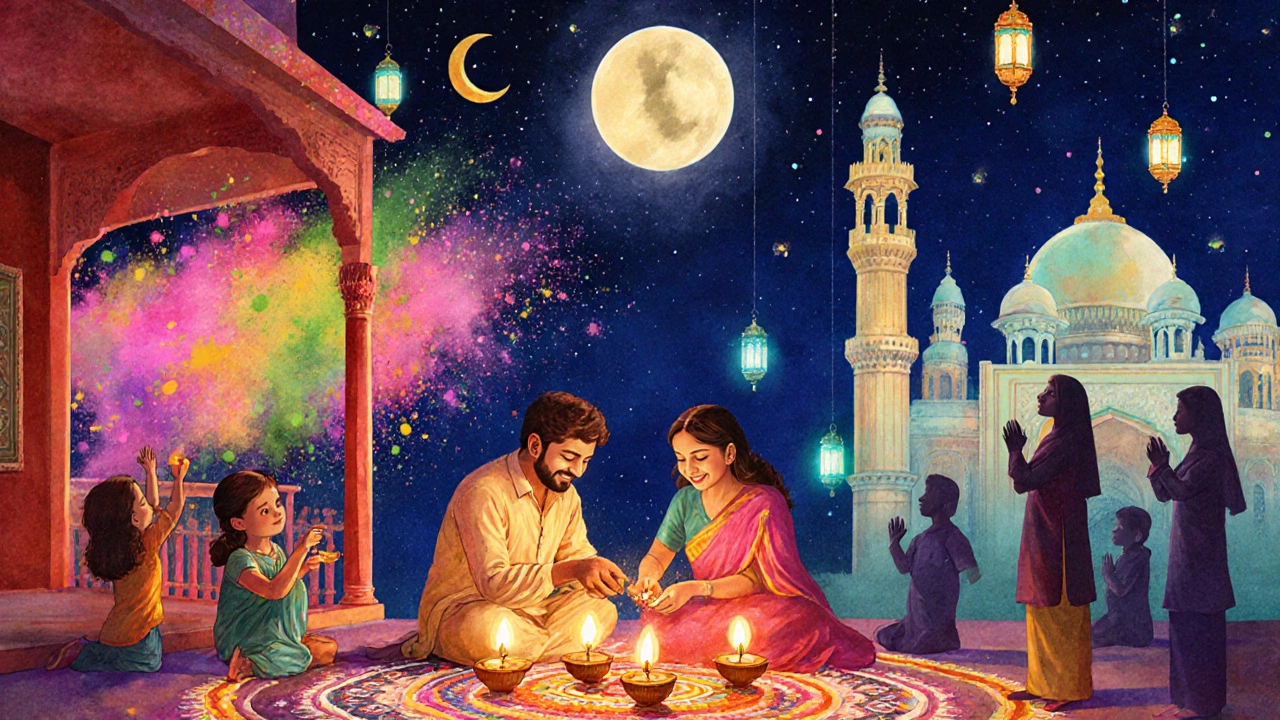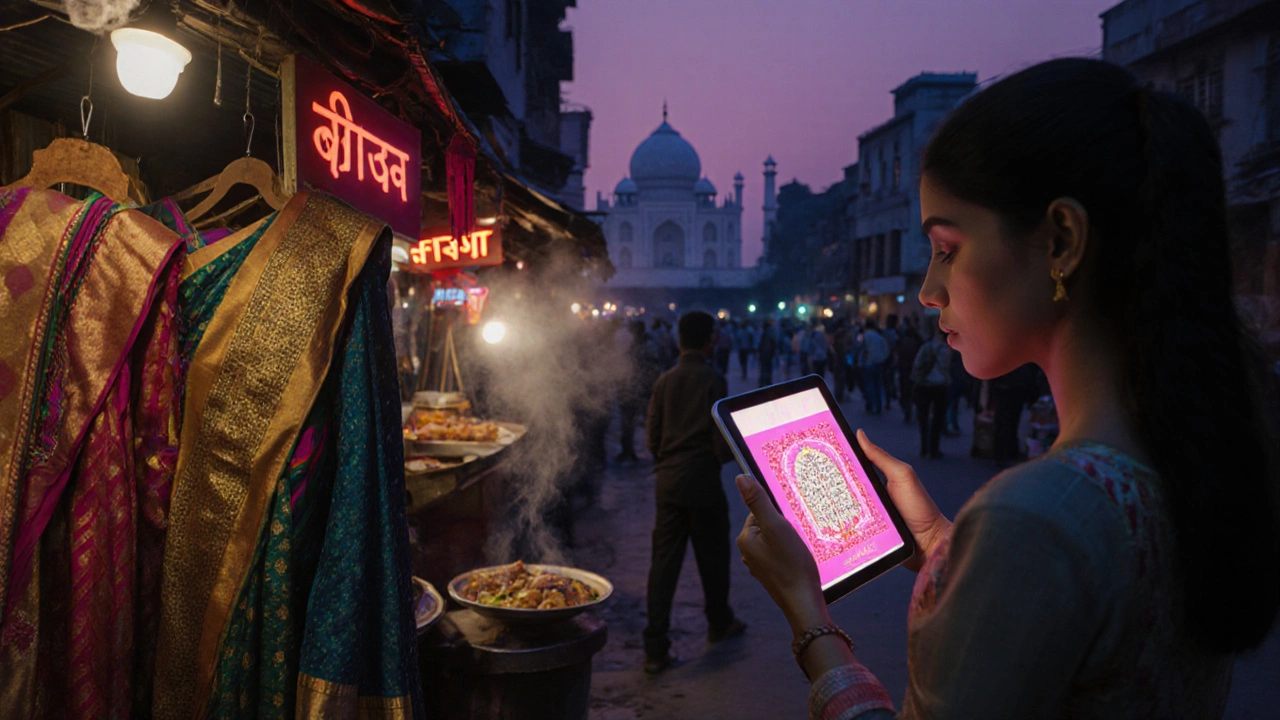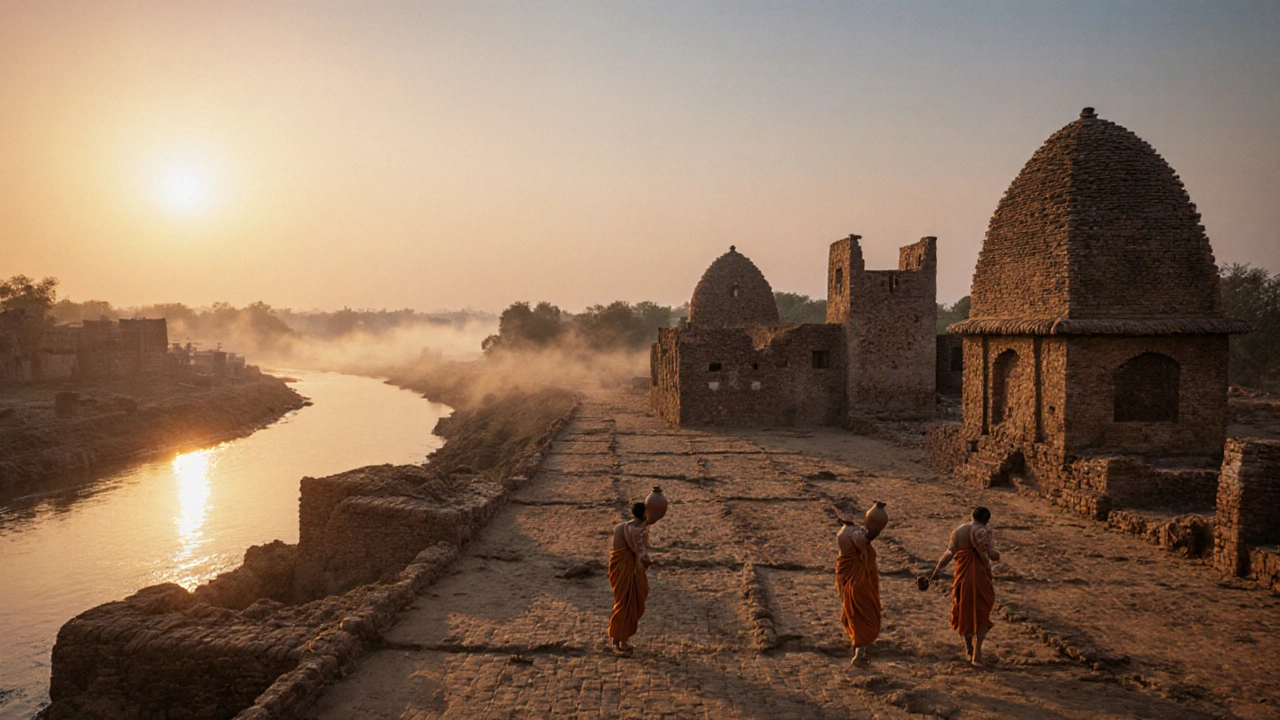Explore India's Cultural Heritage
Select a cultural aspect below to learn more about its significance in India's rich heritage.
Historical Foundations
Ancient civilizations and empires
Religious Mosaic
Diverse faith traditions
Languages & Literature
Linguistic diversity and classics
Festivals & Rituals
Celebrations and traditions
Arts & Crafts
Performing and visual arts
Architecture
Iconic monuments and styles
Culinary Traditions
Regional flavors and dishes
Traditional Clothing
Regional garments and styles
About India's Cultural Heritage
Select a category above to explore its role in shaping India's rich cultural landscape. Each element contributes uniquely to the country's identity, from ancient traditions to contemporary expressions.
India's heritage is a dynamic tapestry woven from thousands of years of history, diverse beliefs, varied languages, colorful celebrations, artistic expressions, architectural marvels, culinary delights, and traditional attire.
Ever wondered what makes Indian cultural heritage so dazzling? From ancient scriptures to bustling street markets, the subcontinent weaves a tapestry of traditions that has fascinated travelers for centuries. This guide walks you through the key pillars-history, religion, languages, festivals, arts, architecture, cuisine, and dress-that together define India’s vibrant legacy.
Historical Foundations
When we talk about India is a South Asian nation whose recorded civilization spans more than five millennia, the first thing to note is the continuity of cultural layers. The Indus Valley civilization (c. 3300-1300BC) left behind urban planning marvels like Mohenjo‑Daro, while the Vedic period introduced the Sanskrit language and early philosophical thought. Successive empires-Maurya, Gupta, Mughal, and British-each added their own flavors, creating a palimpsest where ancient rituals sit beside colonial architecture.
Two trends stand out: a strong oral tradition that preserved myths and epics across generations, and a remarkable adaptability that allowed foreign ideas to be indigenized. This historical elasticity is the bedrock of today’s cultural richness.
Religious Mosaic
Hinduism is the oldest major religion in India, encompassing a spectrum of beliefs, deities, and practices forms the core spiritual framework for about 80% of the population. Its scriptures-the Vedas, Upanishads, Mahabharata, and Ramayana-provide moral guidelines and mythic narratives that seep into daily life, from household rituals to state ceremonies.
Buddhism is a philosophy founded in the 6th centuryBC by Siddhartha Gautama, which spread from India across Asia. Its historic sites, like the Sarnath and Ajanta caves, showcase exquisite murals that blend spiritual teaching with artistic mastery.
Islam, Christianity, Sikhism, Jainism, and numerous tribal faiths also contribute distinct customs, festivals, and architectural styles, making India a true kaleidoscope of belief systems.
Languages and Literature
India recognizes 22 scheduled languages, with Hindi and English serving as official bridges. Yet, regional tongues such as Bengali, Tamil, Marathi, Gujarati, and Punjabi boast their own literary canons. The classical languages-Sanskrit, Tamil, and Telugu-have produced epics, poetry, and drama that continue to influence modern storytelling.
Iconic works like Kalidasa’s "Shakuntala" (Sanskrit drama) and the Tamil "Thirukkural" illustrate how language can encapsulate philosophical depth and everyday wisdom. Contemporary authors such as Arundhati Roy and Salman Rushdie carry forward this tradition, writing for global audiences while rooted in local sensibilities.

Festivals and Rituals
Diwali is the Festival of Lights celebrated by lighting oil lamps, fireworks, and sharing sweets. Symbolizing the triumph of light over darkness, Diwali unites families across religious lines with rituals that include cleaning homes, worshipping Lakshmi, and exchanging gifts.
Other major celebrations-Holi (the riot of colors), Eid al‑Fitr, Guru Nanak Gurpurab, and the harvest festival Pongal-illustrate regional diversity. Each festival follows a unique calendar, culinary repertoire, and set of performances, yet all share communal joy and a reaffirmation of cultural identity.
Arts, Handicrafts, and Performance
From classical to folk, Indian performing arts are a living archive. Kathak is a North Indian classical dance known for its expressive footwork and storytelling gestures, while Bharatanatyam from Tamil Nadu emphasizes geometric precision and sculptural poses.
Music spans the raga‑based Hindustani and Carnatic systems, each with distinct instruments-sitar, tabla, veena, mridangam. Folk traditions like Bhangra from Punjab and Garba from Gujarat keep communal dancing vibrant in villages and urban centers alike.
Handicrafts, such as Pashmina shawls, Mysore silk saris, and intricate lacquerware from Gujarat, showcase regional craftsmanship passed down through generations. These items are not merely decorative; they carry stories of local materials, techniques, and trade routes.
Architectural Marvels
Taj Mahal is a 17th‑century white marble mausoleum in Agra, epitomizing Mughal architectural elegance. Its symmetry, marble inlay work, and surrounding gardens illustrate how imperial ambition fused Persian, Islamic, and Indian motifs.
Other iconic structures-Hampi’s stone bazaars, the rock‑cut temples of Mahabalipuram, the Sikh Golden Temple in Amritsar-reflect local materials and religious symbolism. Even colonial-era buildings, like the Victoria Memorial in Kolkata, add another layer to the architectural narrative.

Culinary Traditions
Indian cuisine is a palate of regional flavors, cooking techniques, and spices. From the fiery chilies of Andhra Pradesh to the sweet millets of Maharashtra, each state boasts signature dishes. Common threads include the use of cumin, turmeric, mustard seeds, and the art of tempering ("tadka").
Street food-pani puri, vada pav, dosa-offers quick, affordable taste experiences, while elaborate thalis showcase a balanced meal of rice, bread, lentils, vegetables, and sweets. Food also plays central roles in festivals: sweets like laddoo during Diwali and payasam during Onam reinforce communal bonds.
Traditional Clothing
Sari is a six‑yard garment draped around the body, worn by women across India with regional variations. Whether it’s the silk brocades of Banaras, the cotton khadi of Gujarat, or the hand‑loomed ikat of Odisha, the sari tells a story of local ecology and craftsmanship.
Men traditionally wear kurta‑pyjama, dhoti, or sherwani for formal occasions. Regional attire-like the Punjabi salwar‑kameez or the Rajasthani bandhani turban-reflects climate, cultural identity, and historic influence.
Continuing the Legacy
India’s cultural heritage isn’t a static museum piece; it lives in daily rituals, evolving art forms, and the diaspora’s reinterpretation abroad. Young creators fuse classical motifs with modern media-think Bollywood music videos sampling folk rhythms or tech startups digitizing ancient manuscripts.
Understanding this heritage means appreciating the depth of each component while seeing how they interlock. Whether you’re planning a trip, studying a language, or simply savoring a spicy curry, you’re engaging with a living tradition that continues to shape identities worldwide.
Frequently Asked Questions
What are the main religions that influence Indian culture?
Hinduism, Islam, Buddhism, Sikhism, Jainism, Christianity and numerous tribal faiths each contribute distinct rituals, festivals, art forms, and philosophical ideas that together form India’s pluralistic cultural fabric.
Which festivals are celebrated nationwide?
Diwali, Holi, Eid al‑Fitr, Christmas, and the harvest festival Pongal are observed across most states, though each region adds its own local customs and cuisines.
How does Indian classical music differ from folk music?
Classical music follows structured ragas and talas, featuring instruments like sitar and veena, while folk music is tied to specific communities, using simpler melodies and everyday instruments such as dholak or shehnai.
What are some iconic Indian architectural styles?
Mughal architecture (e.g., TajMahal), Dravidian temple architecture (e.g., Meenakshi Temple), and colonial British style (e.g., Victoria Memorial) are among the most recognized forms.
Why is the sari considered a cultural symbol?
The sari’s diverse fabrics, regional draping styles, and intricate embroidery reflect local histories, economies, and artistic traditions, making it a wearable narrative of India’s cultural variety.
